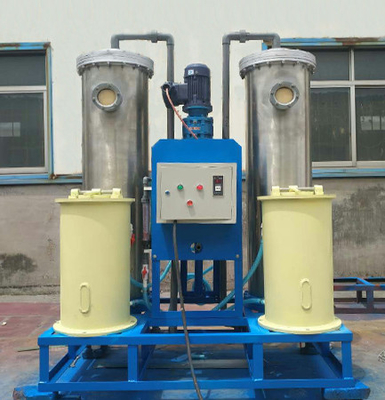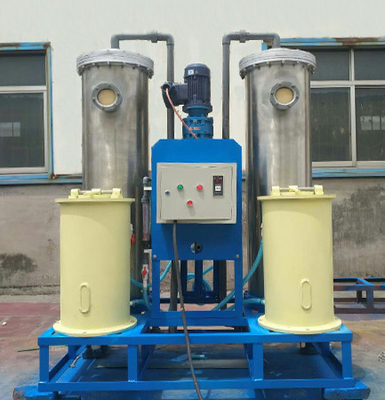-
Condensate Water Recovery Device
-
Reverse Osmosis Equipment
-
Fully Automatic Water Softener
-
Industrial Sand Filter
-
Water Supply Equipment
-
Chemical Dosing Device
-
Container Flipper
-
Container Loading and Unloading Machine
-
Truck Flipper
-
Electric Transfer Cart
-
Electronic Weighbridge
-
Mobile Loading Dock Ramp
-
Air Compressor Heat Recovery
-
Water Treatment Accessories
Stainless Steel 2 Tank Water Softener System Continuous Dual Tank Water Softener

Contact me for free samples and coupons.
Whatsapp:0086 18588475571
Wechat: 0086 18588475571
Skype: sales10@aixton.com
If you have any concern, we provide 24-hour online help.
x| Features | High Automation Level, Stable Water Quality, High Efficiency, Low Energy Consumption, Low Operating Costs. | Origin | Taian, Shandong |
|---|---|---|---|
| Materials | Fiberglass Reinforced Plastic (FRP), Stainless Steel, Carbon Steel | Product Information | Automatic Water Softening Equipment - Dual-Tank, Single-Tank, Continuous Water Production |
| Application Fields | Industrial Boilers, Central Air Conditioning Systems, Heat Exchangers, Hotels, Restaurants, Food And Chemical Industries, Laundry And Dyeing, Medical And Sanitation, Etc. | Product Specifications | 1-100T/H |
| Brand | Tonglida | ||
| Highlight | continuous dual tank water softener,2 tank water softener system continuous,stainless steel 2 tank water softener system |
||
Product Description:
The fully automatic water softener comes equipped with an extensive automatic control system and can be customized as a single-tank or dual-tank system based on the customer's requirements. The overall system works on an automatic mode, with one tank in use while the other serves as a backup.
The softening tank operates through various stages such as running, backwashing, brine suction, ion exchange, forward flushing, and standby. When the operating tank reaches its set water production capacity, the backup tank automatically takes over the operation, and the operating tank goes into regeneration mode.
The raw water flows through the resin tank containing ion exchange resin equipped with an automatic control valve. The exchangeable ions in the resin undergo ion exchange with the cations in the water that result in the softener's outlet water hardness being less than or equal to 0.03mmol/L. Once the system reaches the set flow rate, the regeneration process automatically starts.
The main steps carried out during the regeneration process are as follows:
- Backwashing: Water flushes upward through the resin bed to loosen it while simultaneously removing the accumulated suspended particles from the resin surface.
- Brine Suction Regeneration: After dilution, saturated brine solution is injected through the brine injector into the resin tank. The brine solution flows downwards through the deactivated resin bed, regenerating it and preserving its original exchange capacity.
- Exchange: This process consists of two steps. In the first step, wherein the regeneration liquid is injected, some regeneration brine remains in the upper space of the resin tank that hasn't yet taken part in the regeneration process. To use this brine, the second step involves using clean water with the same flow rate as the regeneration liquid to regenerate the uninvolved brine throughout the resin bed. This step is called exchange. In the second step, the regeneration waste liquid on the resin pores is displaced from the resin bed.
- Forward Flushing: The aim of this step is to entirely remove the remaining regeneration waste liquid from the resin bed and clean it until the water meets the required standards.
| Project Name | Unit | 1T/H | 30T/H | 35T/H | 40T/H | 50T/H | 60T/H | 80T/H | 100T/H | |
| Inlet pressure | mpa | 0.15-0.25 | ||||||||
| Water production | T/H | 0.8-1.2 | 27-33 | 32-38 | 35-45 | 45-55 | 55-65 | 70-90 | 90-110 | |
| Raw water turbidity | O | ≤2 | ||||||||
| Raw water hardness | mmol/L | ≤15 | ||||||||
| Residual hardness of soft water | mmol/L | ≤0.03 | ||||||||
| Self-consumption water rate | % | 4 | ||||||||
| Power supply | Single-phase electricity 50HZ 220V | |||||||||
| Diameter of exchange column | Stainless steel head | mm | ∅750 | ∅750 | ∅900 | ∅900 | ∅1000 | ∅1200 | ∅1400 | |
| Ordinary head | mm | ∅160 | ∅760 | ∅760 | ∅890 | ∅900 | ∅1000 | ∅1180 | ∅1400 | |
| Resin tank height | mm | |||||||||
| Inlet and outlet water pipeline | Solenoid valve | mm | DN15 | DN65 | DN65 | DN80 | DN80 | DN100 | DN125 | DN150 |
| Valve body | mm | DN20 | ||||||||
| Flow meter | L/H | 60 | 600 | 600 | 1000 | 1000 | 2000 | 2000 | 2500 | |
| Resin filling capacity | Solenoid valve | KG | ||||||||
| Total weight of equipment | KG | |||||||||
| Salt tank size | Self-processing | mm | 225*650 | 640*750 | 640*750 | 700*850 | 760*800 | 760*800 | 890*800 | |
| Purchase from outside | 1000L | 1000L | 1500 | 2000 | ||||||
Features:
An elevated level of automation offers numerous advantages, including improved productivity, accuracy, and safety. By incorporating advanced technologies, tasks are completed quicker and with fewer errors.
A stable water quality is vital for various applications, including agriculture, industrial processes, and human consumption. Maintaining stable water quality ensures that equipment operates efficiently and effectively, while minimizing downtime caused by water quality issues.
High efficiency is key to reducing waste and improving overall performance. It ensures that resources are used effectively and that processes are optimized for maximum output.
Low energy consumption helps to minimize environmental impact and reduce costs. Energy-efficient technologies reduce electricity usage, resulting in savings on utility bills and reducing carbon emissions.
Low operating costs are essential for ensuring that businesses remain competitive and profitable. By minimizing overhead expenses, companies can allocate more resources toward research and development, hiring, and other critical areas without compromising performance.
Technical Parameters:
The device ensures automatic control, which provides simple and reliable operation.
This water softener has strong adaptability since it can soften water with high hardness, up to ≤15mmol/L, to a residual hardness of ≤0.03mmol/L in a single pass.
The machine has many benefits, such as low operating costs, low resin consumption, low salt consumption, and stable water quality.
The equipment is lightweight and has a compact and rational design, requiring a small footprint.
The complete machine is delivered from the factory, and installation is simple. Only the inlet and outlet pipes and power supply need to be connected to start water production.
Applications:
The automatic water softener is an essential tool that is widely used for circulating makeup water. It is typically utilized in a variety of systems, including steam boilers, hot water boilers, heat exchangers, steam condensers, air conditioning systems, and direct-fired equipment and systems.
Moreover, the automatic water softener is a versatile tool that is instrumental in domestic and industrial water treatment. In various industries such as food, electroplating, pharmaceuticals, chemicals, printing and dyeing, textiles, and electronics, water softeners play an important role in improving water quality.
Industries that require pre-treatment before desalination systems find automatic water softeners particularly useful. After being treated by single or multi-stage water softeners, the hardness of the produced water can be significantly reduced. This is a crucial step in ensuring the safety and effectiveness of various industrial processes.




